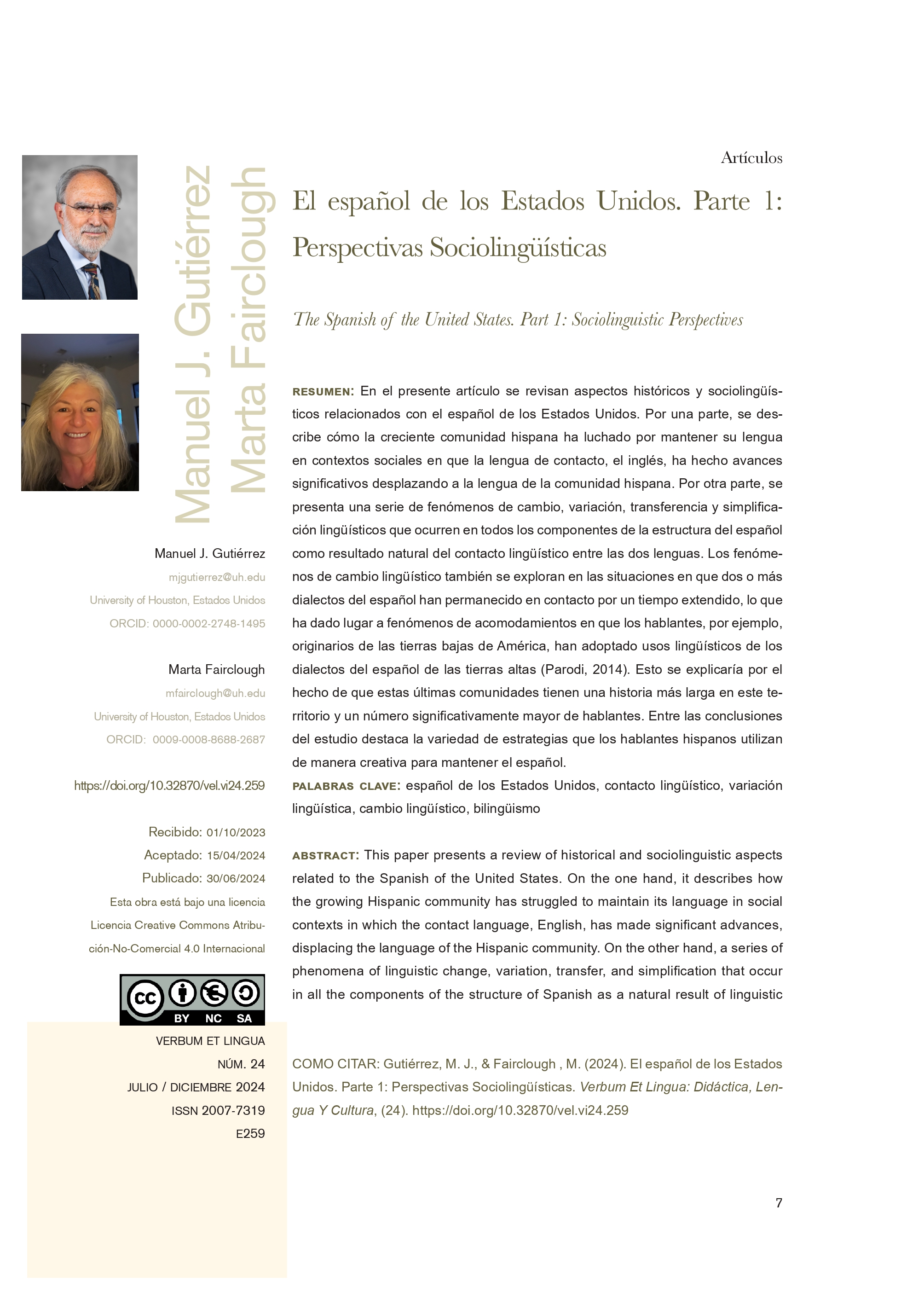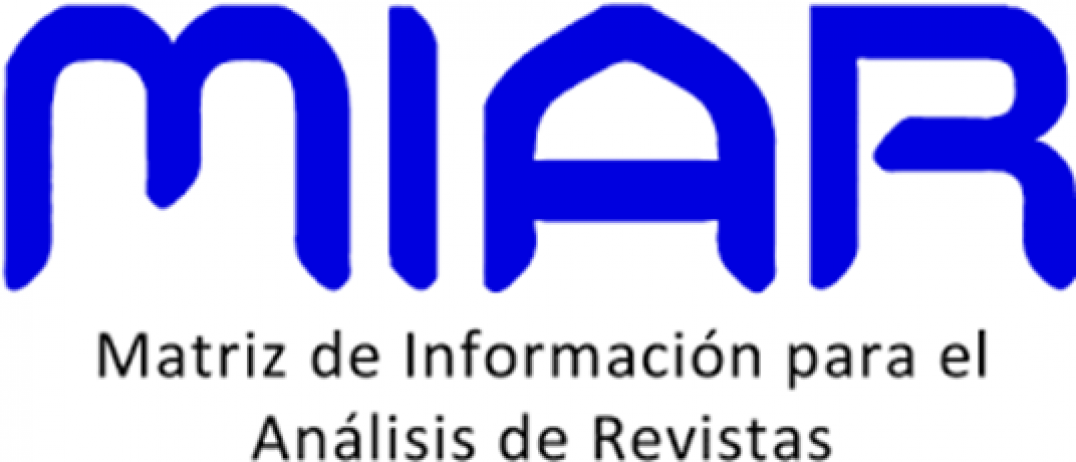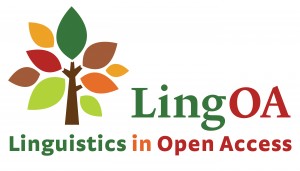The Spanish of the United States. Part 1: Sociolinguistic Perspectives
DOI:
https://doi.org/10.32870/vel.vi24.259Keywords:
U.S. Spanish, linguistic contact, linguistic variation, linguistic change, bilingualismAbstract
This paper presents a review of historical and sociolinguistic aspects related to the Spanish of the United States. On the one hand, it describes how the growing Hispanic community has struggled to maintain its language in social contexts in which the contact language, English, has made significant advances, displacing the language of the Hispanic community. On the other hand, a series of phenomena of linguistic change, variation, transfer, and simplification that occur in all the components of the structure of Spanish as a natural result of linguistic contact between the two languages are presented. The phenomena of linguistic change are also explored in situations in which two or more dialects of Spanish have remained in contact for an extended time, which has given rise to accommodation phenomena in which speakers, for example, originating from the American lowlands have adopted linguistic uses of highland Spanish dialects (Parodi, 2014). This would be explained by the fact that these latter communities have a longer history in this territory and a significantly larger number of speakers. Among the conclusions of the study, the variety of strategies that Hispanic speakers use creatively to maintain Spanish stands out.
Downloads
Metrics
References
Alfaraz, G. (2012). The Status of the Extension of estar in Cuban Spanish. Studies in Hispanic and Lusophone Linguistics, 5(1), 3-26. https://doi.org/10.1515/shll-2012-1118
Álvarez, C. (1991) Code Switching in narrative performance: Social, structural, and pragmatic function in Puerto Rican speech community of East Harlem. En C. A. Klee y L. A. Ramos- García (Eds.), Sociolinguistics of the Spanish-speaking world: Iberia, Latin America, United States (pp. 271-98). Tempe, AZ: Bilingual Press/Editorial Bilingüe.
Callahan, L. (2004). Spanish/English Codeswitching in a Written Corpus. Amsterdam: John Benjamins.
Carreira, M. (2002). The media, marketing and critical mass: Portents of linguistic maintenance. Southwest Journal of Linguistics, 21(2), 37-54. https://link.gale.com/apps/doc/A102342013/AONE?u=anon~42200a93&sid=googleScholar&xid=27768791
Cortés-Torres, M. (2004). ¿Ser o estar? La variación lingüística y social de estar más adjetivo en el español de Cuernavaca, México. Hispania, 87(4), 788–795. https://doi.org/10.2307/20140911
Davies, M. (1995). Analyzing syntactic variation with computer-based corpora: The case of modern Spanish clitic climbing. Hispania, 78, 370-380. DOI:10.2307/345438
Mello, G. (1993). -Ra vs -se subjunctive: A new look at an old topic. Hispania, 76, 235-44.
Elías-Olivares, L. (1979). Language use in a Chicano community: A sociolinguistics approach. En J. B. Pride (Ed.), Sociolinguistic aspects of language learning and teaching (pp. 120 -34). Oxford: Oxford University Press.
Fairclough, M. (2005). Spanish and Heritage Language Education in the U.S.: Struggling with Hypotheticals. Madrid/Frankfurt: Iberoamericana/Vervuert. DOI:10.31819/9783865278944
______ (2003). El (denominado) Spanglish en Estados Unidos: Polémicas y realidades. Revista Internacional de Lingüística Iberoamericana,1 (2), 185-204. https://www.iberoamericana-vervuert.es/EditorialColeccion.aspx?C1=Revista%20Internacional%20de%20Ling%C3%BC%C3%ADstica%20Iberoamericana
Fairclough, M. y Gutiérrez. M. (inédito). El español de los Estados Unidos. Parte 2: Perspectivas educativas. Verbum et Lingua: Didáctica, lengua y cultura.
Gumperz, J. J. (1982). Discourse Strategies. Cambridge: Cambridge University Press.
Gutiérrez, M. J. (2019). Los demostrativos en el español de Houston, Texas. Revista Lingüística Mexicana. Nueva Época, 1, 9-30. https://linguisticamexicana-amla.colmex.mx/index.php/Linguistica_mexicana/article/view/296/488#toc
(2015). Tendencias leístas en el español de Houston. Verbum Et Lingua: Didáctica, Lengua Y Cultura, (7), 141–152. https://doi.org/10.32870/vel.vi7.69
(2008). Restringiendo la subida de clíticos: Reflexividad, modalidad verbal y contacto lingüístico en el español de Houston. Hispanic Research Journal, 9 (4), 299-313. DOI:10.1179/174582008X325078
(2001). Estar innovador en el continuo generacional bilingüe de Houston. Actas del VII Simposio Internacional de Comunicación Social (pp. 210-13). Santiago de Cuba.
(1997). Discurso irreal de pasado en el español de Houston: la disputa continúa, Bulletin of Hispanic Studies, 74 (3), 257-269. https://doi.org/10.1080/000749097760121962
(1996). Tendencias y alternancias en la expresión de condicionalidad en el español hablado en Houston. Hispania, 79 (3), 316-326. https://doi.org/10.2307/345563
(1995). On the future of the future tense in the Spanish of the Southwest. En
C. Silva-Corvalán (Ed.), Spanish in Four Continents: Studies in Language Contact and Bilingualism (pp. 214-226). Washington D. C.: Georgetown University Press.
(1994). Ser y Estar en el Habla de Michoacán, México. México D.F.: Universidad Nacional Autónoma de México.
Hernández, J. E. (2002). Accommodation in a dialect contact situation. Filología y Lingüística, 28 (2), 93-110. https://doi.org/10.15517/rfl.v28i2.4491
(2009). Measuring rates of word-final nasal velarization: The effect of dialect contact on in-group and out-group exchanges. Journal of Sociolinguistics, 13 (5), 583-612. https://doi.org/10.1111/j.1467-9841.2009.00428.x
Hernández, J. E. y Maldonado, R. A. (2012). Reducción de /s/ final de sílaba entre transmigrantes salvadoreños en el sur de Texas. Lengua y migración, 4 (2), 43-67. Recuperado de http://www.redalyc.org/articulo.oa?id=519551813003
Klein, F. (1980). A quantitative study of syntactic and pragmatic indications of change in the Spanish of bilinguals in the U.S. En William Labov (Ed.) Locating language in the time and space (pp. 69-82). New York: Academic Press.
Limerick, P. P. (2018). Variable clitic placement in US Spanish. En J. E. MacDonald (Ed.), Contemporary trends in Hispanic and Lusophone Linguistics: Selected papers from the Hispanic Linguistic Symposium 2015 (pp. 49-70). Amsterdam: John Benjamins.
Lynch, A. (1999). The subjunctive in Miami Cuban Spanish: Bilingualism, contact, and language variability [tesis doctoral]. University of Minnesota: EE. UU.
McClure, E. (1981). Formal and functional aspects of the codeswitched discourse of bilingual children. En R. Durán (Ed.) Latino language and communicative behavior (pp. 69-92). Norwood, NJ: Ablex.
Moreno de Alba, José. (1977). Vitalidad del futuro de indicativo en la norma culta del español hablado en México. En Juan M. Lope Blanch (Ed.), Estudios sobre el español hablado en las principales ciudades de América (pp. 129-46). México, D.F.: UNAM.
Moreno Fernández, F. (2017). Español estadounidense: perfiles lingüísticos y sociales. Glosas, 9 (2), 10-23. Recuperado de https://www.researchgate.net/publication/315707033_Espanol_estadounidense_perfiles_linguisticos_y_sociales
Ocampo, F. (1990). El subjuntivo en tres generaciones de hablantes bilingües. En J. Bergen (Ed.), Spanish in the United States: Sociolingüistic Issues (pp. 39 48). Washington, D.C.: Georgetown University Press.
Ortiz López, L. A. (2000). Extensión de estar en contextos de ser en el español de Puerto Rico: ¿evaluación interna y/o contacto de lenguas? BAPLE: 98-118.
Otheguy, R. (1993). A reconsideration of the notion of loan translation in the analysis of U.S. Spanish. En A. Roca y J. Lipski (Eds.), Spanish in the United States: Linguistic Contact and Diversity (pp. 21-45). Berlin/New York: Mouton de Gruyter.
Otheguy, R., García, O. y Fernández, M. (1989). Transferring, switching, and modeling in west New York Spanish: An intergenerational study. International Journal of the Sociology of Language, 79 (1989), 41-52. https://doi.org/10.1515/ijsl.1989.79.41
Parodi, C. (2014). El español de tierras altas y tierras bajas: sus reflejos en el español de Los Ángeles. En A. E. Arias, M. J. Gutiérrez, M. A. Landa Arevalillo y F. A. Ocampo (Coord.), Perspectives in the Study of Spanish Language Variation: Papers in Honor of Carmen Silva-Corvalán (pp. 341-372). España: Universidad de Santiago de Compostela, Servicio de Publicaciones
(2004). Contacto de dialectos en Los Ángeles: español chicano y español mexicano. Séptimo Encuentro Internacional de Lingüística en el Noroeste. T 2. Hermosillo: Universidad de Sonora, pp. 277-293.
Pew Research Center. (2021). Key facts about U.S. Latinos for National Hispanic Heritage Month. https://www.pewresearch.org/fact-tank/2021/09/09/key-facts-about-u-s-latinos-for-national-hispanic-heritage-month/
Pfaff, C. (1982). Constraints on language mixing: Intrasentential code-switching and
borrowing in Spanish/English. En J. Amastae y L. Elías-Olivares (Eds.), Spanish in the United States: Sociolinguistic Aspects (pp. 264-97). New York: Cambridge.
Poplack, S. (1982). Sometimes I'll start a sentence in Spanish y término en español: A typology of code-switching. En J. Amastae y L. Elías-Olivares (Eds.), Spanish in the United States: Sociolinguistic aspects (pp. 230-63). New York: Cambridge.
Potowski, K. (2011). Intrafamilial dialect contact. En Manuel Díaz-Campos (Ed.) The Handbook of Hispanic Sociolinguistics (pp. 578-597). Sussex: Wiley- Blackwell.
(2008). ‘I was raised talking like my mom’: the influence of mothers in the development of MexiRicans, phonological and lexical features. En J. Rothman y M. Niño-Murcia (Eds.), Linguistic identity and bilingualism in different Hispanic contexts (pp. 201-220). Amsterdam: John Benjamins.
Raymond, C. (2012a). Generational Divisions: Dialect Divergence in a Los Angeles-Salvadoran Household. Hispanic Research Journal, 13 (4), 297-316. DOI:10.1179/1468273712Z.00000000017
(2012b). Reallocation of pronouns through contact: In-the-moment identity construction amongst Southern California Salvadorans. Journal of Sociolinguistics, 16(5), 669-690. https://doi.org/10.1111/josl.12001
Ronquest, R. y Rao, R. (2018). Heritage Spanish phonetics and phonology. En K. Potowski (Ed.), The Routledge Handbook of Spanish as a Heritage Language (pp. 164-177). New York: Routledge.
Sánchez, R. (1983). Chicano Discourse: Socio-historic Perspectives. Rowley, MA: NewBury House.
Schwenter, S. A., y Torres Cacoullos, R. (2014). Competing constraints on the variable placement of direct object clitics in Mexico City Spanish. Revista Española de Lingüística Aplicada, 27(2), 514-536. https://doi.org/10.1075/resla.27.2.13sch
Silva-Corvalán, C. (1994). Language Contact and Change: Spanish in Los Angeles. Oxford: Clarendon Press.
(1986). Bilingualism and language change: The extension of estar in Los Angeles Spanish. Language, 62, 587-608. https://doi.org/10.2307/415479
Silva-Corvalán, C. y Enrique-Arias, A. (2017). Sociolingüística y pragmática del español. Washington, DC: Georgetown University Press.
Silva-Corvalán, C. y Gutiérrez, M. (1995). On transfer and simplification: Verbal clitics in Mexican-American Spanish. En P. Hashemipour, R. Maldonado, y M. van Naerssen (Eds.), Studies in language learning and Spanish linguistics in honor of Tracy D. Terrell (pp. 302–312). San Francisco: McGraw-Hill.
Thomason, S. y Kaufman, T. (1998). Language Contact, Creolization, and Genetic Llinguistics. Berkeley: University of California Press.
Torres, L. (1997). Puerto Rican Discourse: A Sociolinguistic Study of a New York Suburb. Mahwah, NJ: Lawrence Erlbaum Associates.
USA Facts. (2021). The Hispanic population has quadrupled in the past four decades. https://usafacts.org/articles/demographics-hispanic-americans/?utm_source=google&utm_medium=cpc&utm_campaign=ND-Immigration&gclid=Cj0KCQiAsqOMBhDFARIsAFBTN3dv96fcPcDtlPqrWmDcObrdDKwdMkGxcSc_YoL_SUVebFQcLZhRwu8aAkvaEALw_wcB
Valdés-Fallis, G. (1976). Social interaction and code-switching patterns: A case study of Spanish/English alternation. En G. Keller, R. Teschner y S. Viera (Eds.), Bilingualism in the bicentennial and beyond (pp. 53-85). New York: Bilingual Press.
Weinreich, Uriel. (1974 [1953]). Languages in Contact. The Hague: Mouton.
Zentella, A. C. (1990). Lexical leveling in four New York City Spanish dialects: Linguistic and social factors. Hispania, 73 (4), 1094-1105. http://dx.doi.org/10.2307/344311

Downloads
Published
Versions
- 2025-07-17 (6)
- 2025-07-01 (5)
- 2024-11-08 (4)
- 2024-07-31 (3)
- 2024-09-19 (2)
- 2024-07-23 (1)












